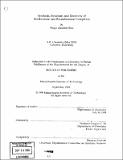Synthesis, structure, and reactivity of borabenzene and boratabenzene complexes
Author(s)
Hoic, Diego Andrés, 1970-
DownloadFull printable version (38.28Mb)
Advisor
Gregory C. Fu.
Terms of use
Metadata
Show full item recordAbstract
Although complexes derived from anionic borabenzenes (boratabenzenes) had been used for a long time, little was known about their neutral counterparts, mostly because an easy synthetic entry to them was not available. A facile three-step synthesis that allows the preparation of large quantities of neutral borabenzenes in three days, from commercially available starting materials is described in Chapter 2. In Chapter 3 it is shown that neutral borabenzenes can be converted into anionic boratabenzenes, thereby providing a versatile new synthesis of this family of compounds. The solid state structures of these complexes are described. The developments in Chapters 2 and 3 allowed us to continue on to studies of both borabenzene and boratabenzene complexes. Chapter 4 deals with the complexation of borabenzenes and boratabenzenes to some common transition metal fragments, mostly Cr(CO)3 and [Rh(olefin) 2 ]+ , as well as structural studies thereof. We also discuss the interconversion between borabenzene- and boratabenzene-metal complexes. Chapter 5 deals with the chemistry of the parent 1-H-boratabenzene. We discuss its synthesis, structure (in the solid state and in solution), and reactivity. In this chapter it is shown that the B-H is hydridic, and that the ring can form R-complexes with transition metals. The electron-donating ability of 1-H-boratabenzene is shown to lie somewhere between that of benzene and of Cp. Chapter 6 is concerned with the chemistry of diphenylphosphidoboratabenzene. This molecule is unique among boratabenzenes in that it prefers to bind main group electrophiles and transition metals through its boron substituent. Solid state structural studies establish that it has the same steric bulk as triphenylphosphine. Comparative studies of its transition metal complexes show that it is considerably more electron-donating than triphenylphosphine.
Description
Thesis (Ph.D.)--Massachusetts Institute of Technology, Dept. of Chemistry, 1998. Vita. Includes bibliographical references.
Date issued
1998Department
Massachusetts Institute of Technology. Department of ChemistryPublisher
Massachusetts Institute of Technology
Keywords
Chemistry